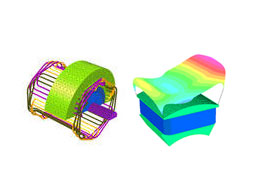Latest News
December 4, 2001
By Anthony J. Lockwood
Dear Desktop Engineering Reader:
 A few weeks back, I mentioned that I am awed by ballet. Now I can say that I’m also amazed by Opera. No, I don’t mean chubby people in frilly getups belting out a dramatic tale in song, albeit that’s some pretty wild stuff too. Rather, I mean the Opera toolset for simulating static and time varying electromagnetic fields as well as the multiple physics phenomena associated with it.
A few weeks back, I mentioned that I am awed by ballet. Now I can say that I’m also amazed by Opera. No, I don’t mean chubby people in frilly getups belting out a dramatic tale in song, albeit that’s some pretty wild stuff too. Rather, I mean the Opera toolset for simulating static and time varying electromagnetic fields as well as the multiple physics phenomena associated with it.
Opera started out in the mid-80s as the genius emerging from an outfit called Vector Fields, which was acquired not so long ago by Cobham Technical Services in the UK, a company that specializes in electromagnetic analysis and design software. Today the combined entity is known as Cobham Technical Services - Vector Fields Software.
Anyway, the skinny on Opera is that it’s a general-purpose finite element system for designing, simulating, and optimizing electromagnetic devices ranging from low-frequency motors to plasma devices and transformers to superconducting magnets. You can work in 2D and in 3D. It supports multiple physics analyses, such as thermal and stress. It can handle permanent magnet magnetization / demagnetization, hysteresis in soft magnetic materials, and linear and rotating machinery designs. You can import CAD files or you can use it to design your model. Meshing is automatic. Opera seems to be engineered so that both the FEA novice and the old pro can use it, meaning that efficiency is a key part of its operating philosophy.
All that is fine and dandy, I hear you mutter, while asking “so, what’s in Opera for me?” Well, that’s what the pair of on-demand webinars in today’s Check It Out could answer for you. Neither is really a demo. (The company will be happy to arrange a full-blown demo for you.) Rather, they are overviews of the capabilities that Opera brings to your toolkit, with one webinar more tightly focused than the other.
The first video, “Introduction to Rotating Electrical Machine Design Using Opera,” is the more basic of the two, so definitely watch this one first if this is all new to you. It starts at the fundamental FEA level in an electromagnetic / electromechanical sense—say defining geometry, meshing, and material properties. It then gets increasingly detailed on the abilities Opera brings to designing and analyzing rotating electrical machines.
The second video, “Multiphysics Simulation in Opera,” is more narrowly focused, but it will not be all Greek to the uninitiated in the topic. It looks at Opera’s ability to couple its electromagnetic analysis and thermal and stress solutions, enabling you to analyze things like electric motors, magnets, and electron beam devices. Like the first webinar, the capabilities of the software are discussed and explained rather than a full-blown demo presented.
Both of these webinars run about 48 minutes. It’s easy to skip around using the event index on the left. Both are, um, understated. You know, no operatic music, gushing verbiage, or silky-voiced presenter. Information is provided clearly, succinctly, and professionally. Anybody who currently or will soon be charged with designing electric motors or generators, or analyzing electromagnetic or electromechanical effects will benefit from these webinars.
Thanks, Pal. – Lockwood
Anthony J. Lockwood
Editor at Large, Desktop Engineering
Introduction to Rotating Electrical Machine Design Using Opera
Subscribe to our FREE magazine, FREE email newsletters or both!
Latest News
About the Author
Anthony J. Lockwood is Digital Engineering’s founding editor. He is now retired. Contact him via [email protected].
Follow DE





